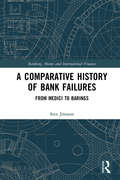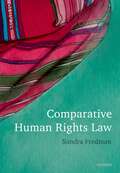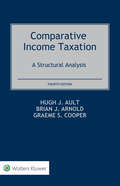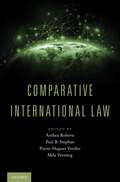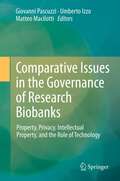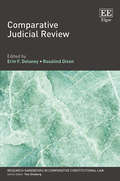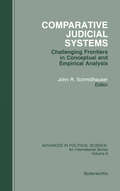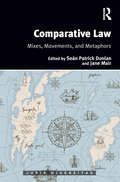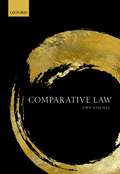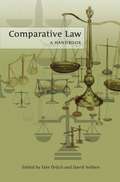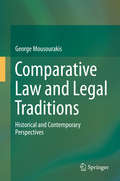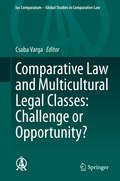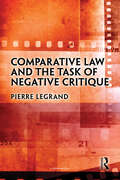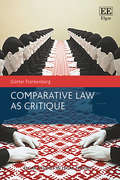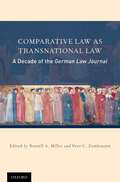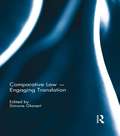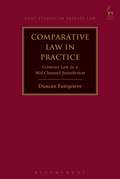- Table View
- List View
A Comparative History of Bank Failures: From Medici to Barings (Banking, Money and International Finance)
by Sten JonssonStarting with Medici and Fugger and ending with Barings and Royal Bank of Scotland under neo-liberal de-regulation, the author gives an account of how a number of banks failed over a 500 year-period. The author offers an explanation of the leading ideas about the world and good society at the time, and summarizes this narrative using Streeck & Schmitter’s three bases for regulation of society: Community (spontaneous solidarity), State (hierarchical control), and Market (dispersed competition). The bank failures are presented in the context of social philosophies of the day (scholasticism, mercantilism, neo-liberalism, and libertarianism), and the changing business practices (Bills of Exchange, rents and financial instruments of various kinds). The dominating explanation of financial crises has been market-related. Here, the author argues that managerial failures are an important contributor. He demonstrates the failure of management to act on early signals such as existential risk, strategic stress syndrome, and lack of proper oversight by top management. The author encourages a return to ethical principles for banks, suggesting that his ethical aspect should be at the core of the credit process of banks in the future. With its interdisciplinary approach, this book will be an important contribution to the discussion surrounding bank failures. It will interest any scholar looking at the origins of financial crises and will be particularly useful for post-graduate students of economic and financial history, banking, finance and accounting.
Comparative Human Rights Law
by Sandra FredmanCourts in different jurisdictions face similar human rights questions. Does the death penalty breach human rights? Does freedom of speech include racist speech? Is there a right to health? This book uses the prism of comparative law to examine the fascinating ways in which these difficult questions are decided. On the one hand, the shared language of human rights suggests that there should be similar solutions to comparable problems. On the other hand, there are important differences. Constitutional texts are worded differently; courts have differing relationships with the legislature; and there are divergences in socio-economic development, politics, and history. Nevertheless, there is a growing transnational conversation between courts, with cases in one jurisdiction being cited in others. Part I sets out the cross-cutting themes which shape the ways judges respond to challenging human rights issues. It examines when it is legitimate to refer to foreign materials; how universality and cultural relativity are balanced in human rights law; the appropriate role of courts in adjudicating human rights in a democracy; and the principles judges use to interpret human rights texts. The book is unusual in transcending the distinction between socio-economic rights and civil and political rights. Part II applies these cross-cutting themes to comparing human rights law in the US, UK, South Africa, Canada, and India. Its focus is on seven particularly challenging issues: the death penalty, abortion, housing, health, speech, education and religion, with the aim of inspiring further comparative examination of other pressing human rights issues.
Comparative Human Rights Law
by Sandra FredmanCourts in different jurisdictions face similar human rights questions. Does the death penalty breach human rights? Does freedom of speech include racist speech? Is there a right to health? This book uses the prism of comparative law to examine the fascinating ways in which these difficult questions are decided. On the one hand, the shared language of human rights suggests that there should be similar solutions to comparable problems. On the other hand, there are important differences. Constitutional texts are worded differently; courts have differing relationships with the legislature; and there are divergences in socio-economic development, politics, and history. Nevertheless, there is a growing transnational conversation between courts, with cases in one jurisdiction being cited in others. Part I sets out the cross-cutting themes which shape the ways judges respond to challenging human rights issues. It examines when it is legitimate to refer to foreign materials; how universality and cultural relativity are balanced in human rights law; the appropriate role of courts in adjudicating human rights in a democracy; and the principles judges use to interpret human rights texts. The book is unusual in transcending the distinction between socio-economic rights and civil and political rights. Part II applies these cross-cutting themes to comparing human rights law in the US, UK, South Africa, Canada, and India. Its focus is on seven particularly challenging issues: the death penalty, abortion, housing, health, speech, education and religion, with the aim of inspiring further comparative examination of other pressing human rights issues.
Comparative Income Taxation: A Structural Analysis
by Brian J. Arnold Hugh J. Ault Graeme CooperComparative Income Taxation A Structural Analysis Fourth Edition Hugh J. Ault, Brian J. Arnold & Graeme S. Cooper In complex national income tax systems, structural and design variations from one country to another present major obstacles to the kind of comparative understanding that economic globalization requires. Hence the great significance of this outstanding book, highly acclaimed through three previous editions and now thoroughly updated to encompass the latest changes and trends. In it, leading authorities from eleven of the world’s most important national taxation systems each contribute their particular expertise to a study of specific crucial problems of tax design. In addition to the nine countries covered in previous editions—Australia, Canada, France, Germany, Japan, the Netherlands, Sweden, the United Kingdom and the United States—China and India have now been added to provide the perspective of developing countries. Individually authored country descriptions outline the climate and institutional framework in which each of the eleven national taxation systems’ substantive rules operate. All the country descriptions are analyzed in accordance with a common format to facilitate comparisons of the ways in which the countries’ tax systems are similar and in which they differ. They form the background to an expertly informed comparative analysis focusing on three major areas: basic income taxation, taxation of business organizations and international taxation. Most of the rules especially important for international business and investment are dealt with here, including (among many others) rules on the following: classification of business entities; taxation of corporations and their shareholders; corporate organization and restructuring; taxation of partnerships; residence and source taxation; controlled foreign company rules; restrictions on the deduction of interest; courts dealing with tax matters; and effect of tax treaties. Several new topics—including the classification of employees and independent contractors, the taxation of pensions, patent box regimes, the taxation of indirect transfers and the tax challenges of the digital economy—have been added. Especially timely are discussions of changes stemming from the G20/OECD Base Erosion and Profit Shifting project. The introduction has also been expanded to include a new section on European Union (EU) law as it affects the tax laws of EU Member States. This new edition of a classic source of information and analysis for students, professors, researchers, tax practitioners and tax policy officials on the different ways that countries design their income tax systems will be widely welcomed by the international tax community.
Comparative International Law
by Anthea Roberts, Paul B. Stephan, Pierre-Hugues Verdier and Mila VersteegBy definition, international law, once agreed upon and consented to, applies to all parties equally. It is perhaps the one area of law where cross-country comparison seems inappropriate, because all parties are governed by the same rules. However, as this book explains, states sometimes adhere to similar, and at other times, adopt different interpretations of the same international norms and standards. International legal rules are not a monolithic whole, but are the basis for ongoing contestation in which states set forth competing interpretations. International norms are interpreted and redefined by national executives, legislatures, and judiciaries. These varying and evolving interpretations can, in turn, change and impact the international rules themselves. These similarities and differences make for an important, but thus far, largely unexamined object of comparison. This is the premise for this book, and for what the editors call "comparative international law." This book achieves three objectives. The first is to show that international law is not a monolith. The second is to map the cross-country similarities and differences in international legal norms in different fields of international law, as well as their application and interpretation with regards to geographic differences. The third is to make a first and preliminary attempt to explain these differences. It is organized into three broad thematic sections, exploring: conceptual matters, domestic institutions and comparative international law, and comparing approaches across issue-areas. The chapters are authored by contributors who include leading international law and comparative law scholars with diverse backgrounds, experience, and perspectives.
Comparative International Law
By definition, international law, once agreed upon and consented to, applies to all parties equally. It is perhaps the one area of law where cross-country comparison seems inappropriate, because all parties are governed by the same rules. However, as this book explains, states sometimes adhere to similar, and at other times, adopt different interpretations of the same international norms and standards. International legal rules are not a monolithic whole, but are the basis for ongoing contestation in which states set forth competing interpretations. International norms are interpreted and redefined by national executives, legislatures, and judiciaries. These varying and evolving interpretations can, in turn, change and impact the international rules themselves. These similarities and differences make for an important, but thus far, largely unexamined object of comparison. This is the premise for this book, and for what the editors call "comparative international law." This book achieves three objectives. The first is to show that international law is not a monolith. The second is to map the cross-country similarities and differences in international legal norms in different fields of international law, as well as their application and interpretation with regards to geographic differences. The third is to make a first and preliminary attempt to explain these differences. It is organized into three broad thematic sections, exploring: conceptual matters, domestic institutions and comparative international law, and comparing approaches across issue-areas. The chapters are authored by contributors who include leading international law and comparative law scholars with diverse backgrounds, experience, and perspectives.
Comparative Issues in the Governance of Research Biobanks: Property, Privacy, Intellectual Property, and the Role of Technology
by Giovanni Pascuzzi, Umberto Izzo and Matteo MacilottiIn the last few years, the boom in biobanking has prompted a lively debate on a host of interrelated legal issues, such as the Gordian knot of the ownership of biological materials, as well as privacy concerns. The latter are due to the difficulty of accepting that biological samples must be completely anonymous without making it practically impossible to exploit their information potential. The issues also include the delicate role and the changing content of the donor’s “informed consent” as the main legal tool that may serve to link the privacy and property interests of donors with the research interests and the set of principles that should be at the core of the biobanking practice. Lastly, the IP issues and the patentability of biological samples as well as the protection of databases storing genetic information obtained from the samples are covered. Collecting eighteen essays written by eminent scholars from Italy, the US, the UK and Canada, this book provides new solutions to these problems. From a comparative viewpoint, it explores the extent to which digital technology may assist in tackling the numerous regulatory issues raised by the practice of biobanking for research purposes. These issues may be considered and analyzed under the traditional paradigms of Property, Privacy, Informed Consent and Intellectual Property.
Comparative Judicial Review (Research Handbooks in Comparative Constitutional Law series)
by Erin F. Delaney Rosalind DixonConstitutional courts around the world play an increasingly central role in day-to-day democratic governance. Yet scholars have only recently begun to develop the interdisciplinary analysis needed to understand this shift in the relationship of constitutional law to politics. This edited volume brings together leading scholars of constitutional law and politics to provide a comprehensive overview of judicial review, covering theories of its creation, mechanisms of its constraint, and its comparative applications, including theories of interpretation and doctrinal developments. This book serves as a single point of entry for legal scholars and practitioners interested in understanding the field of comparative judicial review in its broader political and social context. This book’s comparative and interdisciplinary accounts of a phenomenon of worldwide significance and its advanced introduction to the origins, functions, and contours of judicial review make it both accessible and indispensable. Comparative Judicial Review should be considered essential reading for every graduate student, early career scholar, and constitutional law professor seeking to become more comparative in their approach.
Comparative Judicial Systems: Challenging Frontiers in Conceptual and Empirical Analysis
by John R. SchmidhauserComparative Judicial Systems: Challenging Frontiers in Conceptual and Empirical Analysis is a comprehensive and cohesive collection of investigative essays written by significant contributors in the field of comparative judicial institutions and politics. These essays seek to explain the judicial systems of different nations and analyze their implications. The book is divided into three parts. Part I deals with the integration of courts into the study of politics and conceptual frameworks in comparative cross-national legal and judicial research. Part II covers analyses of the judicial systems of a certain nation, while Part III compares and analyzes judicial systems of different nations as well as their judicial background in relation to their subculture. The text is recommended for lawyers as well as those in the field of political science and in the judicial branch, especially those who are looking to countries as examples for the improvement of their local systems.
Comparative Law: Mixes, Movements, and Metaphors (Juris Diversitas #30)
by Seán Patrick Donlan Jane MairThis book discusses a number of important themes in comparative law: legal metaphors and methodology, the movements of legal ideas and institutions and the mixity they produce, and marriage, an area of law in which culture – or clashes of legal and public cultures – may be particularly evident. In a mix of methodological and empirical investigations divided by these themes, the work offers expanded analyses and a unique cross-section of materials that is on the cutting edge of comparative law scholarship. It presents an innovative approach to legal pluralism, the study of mixed jurisdictions, and language and the law, with the use of metaphors not as an illustration but as a core element of comparative methodology.
Comparative Law
by Uwe KischelUwe Kischel's comprehensive treatise on comparative law offers a critical introduction to the central tenets of comparative legal scholarship. The first part of the book is dedicated to general aspects of comparative law. The controversial question of methods, in particular, is addressed by explaining and discussing different approaches, and by developing a contextual approach that seeks to engage with real-world issues and takes a practical perspective on contemporary comparative legal scholarship. The second part of the book offers a detailed treatment of the major legal contexts across the globe, including common law, civil law systems (based on Germany and France, and extended to Eastern Europe, Scandinavia, and Latin America, among others), the African context (with an emphasis on customary law), different contexts in Asia, Islamic law and law in Islamic countries (plus a brief treatment of Jewish law and canon law), and transnational contexts (public international law, European Union law, and lex mercatoria). The book offers a coherent treatment of global legal systems that aims not only to describe their varying norms and legal institutions but to propose a better way of seeking to understand how the overall context of legal systems influences legal thinking and legal practice.
Comparative Law: Washington 2010
by Uwe KischelUwe Kischel's comprehensive treatise on comparative law offers a critical introduction to the central tenets of comparative legal scholarship. The first part of the book is dedicated to general aspects of comparative law. The controversial question of methods, in particular, is addressed by explaining and discussing different approaches, and by developing a contextual approach that seeks to engage with real-world issues and takes a practical perspective on contemporary comparative legal scholarship. The second part of the book offers a detailed treatment of the major legal contexts across the globe, including common law, civil law systems (based on Germany and France, and extended to Eastern Europe, Scandinavia, and Latin America, among others), the African context (with an emphasis on customary law), different contexts in Asia, Islamic law and law in Islamic countries (plus a brief treatment of Jewish law and canon law), and transnational contexts (public international law, European Union law, and lex mercatoria). The book offers a coherent treatment of global legal systems that aims not only to describe their varying norms and legal institutions but to propose a better way of seeking to understand how the overall context of legal systems influences legal thinking and legal practice.
Comparative Law: Mixes, Movements, and Metaphors (Juris Diversitas)
by Jane Mair Sean Patrick DonlanThis book discusses a number of important themes in comparative law: legal metaphors and methodology, the movements of legal ideas and institutions and the mixity they produce, and marriage, an area of law in which culture – or clashes of legal and public cultures – may be particularly evident. In a mix of methodological and empirical investigations divided by these themes, the work offers expanded analyses and a unique cross-section of materials that is on the cutting edge of comparative law scholarship. It presents an innovative approach to legal pluralism, the study of mixed jurisdictions, and language and the law, with the use of metaphors not as an illustration but as a core element of comparative methodology.
Comparative Law: A Handbook (Jcl Studies In Comparative Law Ser. #8)
by Esin Örücü David NelkenThis innovative, refreshing, and reader-friendly book is aimed at enabling students to familiarise themselves with the challenges and controversies found in comparative law. At present there is no book which clearly explains the contemporary debates and methodological innovations found in modern comparative law. This book fills that gap in teaching at undergraduate level, and for postgraduates will be a starting point for further reading and discussion. Among the topics covered are: globalisation, legal culture, comparative law and diversity, economic approaches, competition between legal systems, legal families and mixed systems, comparative law beyond Europe, convergence and a new ius commune, comparative commercial law, comparative family law, the 'common core' and the 'better law' approaches, comparative administrative law, comparative studies in constitutional contexts, comparative law for international criminal justice, judicial comparativism in human rights, comparative law in law reform, comparative law in courts and a comparative law research project. The individual chapters can also be read as stand-alone contributions and are written by experts such as Masha Antokolskaia, John Bell, Roger Cotterell, Sjef van Erp, Nicholas Foster, Patrick Glenn, Andrew Harding, Peter Leyland, Christopher McCrudden, Werner Menski, David Nelken, Anthony Ogus, Esin Örücü, Paul Roberts, Jan Smits and William Twining. Each chapter begins with a description of key concepts and includes questions for discussion and reading lists to aid further study.Traditional topics of private law, such as contracts, obligations and unjustified enrichment are omitted as they are amply covered in other comparative law books, but developments in other areas of private law, such as family law, are included as being of current interest.
Comparative Law: A Handbook
This innovative, refreshing, and reader-friendly book is aimed at enabling students to familiarise themselves with the challenges and controversies found in comparative law. At present there is no book which clearly explains the contemporary debates and methodological innovations found in modern comparative law. This book fills that gap in teaching at undergraduate level, and for postgraduates will be a starting point for further reading and discussion. Among the topics covered are: globalisation, legal culture, comparative law and diversity, economic approaches, competition between legal systems, legal families and mixed systems, comparative law beyond Europe, convergence and a new ius commune, comparative commercial law, comparative family law, the 'common core' and the 'better law' approaches, comparative administrative law, comparative studies in constitutional contexts, comparative law for international criminal justice, judicial comparativism in human rights, comparative law in law reform, comparative law in courts and a comparative law research project. The individual chapters can also be read as stand-alone contributions and are written by experts such as Masha Antokolskaia, John Bell, Roger Cotterell, Sjef van Erp, Nicholas Foster, Patrick Glenn, Andrew Harding, Peter Leyland, Christopher McCrudden, Werner Menski, David Nelken, Anthony Ogus, Esin Örücü, Paul Roberts, Jan Smits and William Twining. Each chapter begins with a description of key concepts and includes questions for discussion and reading lists to aid further study.Traditional topics of private law, such as contracts, obligations and unjustified enrichment are omitted as they are amply covered in other comparative law books, but developments in other areas of private law, such as family law, are included as being of current interest.
Comparative Law and Anthropology (Research Handbooks in Comparative Law series)
by James A. R. NafzigerThis cutting-edge Research Handbook, at the intersection of comparative law and anthropology, explores mutually enriching insights and outlooks. The 20 contributors, including several of the most eminent scholars, as well as new voices, offer diverse expertise, national backgrounds and professional experience. Their overall approach is "ground up" without regard to unified paradigms of research or objects of study. Through a pluralistic definition of law and multidisciplinary approaches, Comparative Law and Anthropology significantly advances both theory and practice. The Research Handbook’s expansive concept of comparative law blends a traditional geographical orientation with historical and jurisprudential dimensions within a broad range of contexts of anthropological inquiry, from indigenous communities, to law schools and transitional societies. This comprehensive and original collection of diverse writings about anthropology and the law around the world offers an inspiring but realistic source for legal scholars, anthropologists and policy-makers.
Comparative Law and Legal Traditions: Historical and Contemporary Perspectives
by George MousourakisThe primary aim of this book is to provide clear and reliable information on a number of central topics in comparative law. At a time when global society is increasingly mobile and legal life is internationalized, the role of comparative law is gaining importance. While the growing interest in this field may well be attributed to the dramatic increase in international legal transactions, this empirical parameter is only part of the explanation. The other part, and (at least) equally important, has to do with the expectation of gaining a deeper understanding of law as a social phenomenon and a fresh insight into the current state and future direction of one’s own legal system. In response to the internationalization of legal practice and theory, law schools around the world have expanded their comparative law programs. Within the legal subjects that form the core of the curriculum there is a greater interest in comparative legal analysis, as well as greater attention to how global developments and international actors and institutions affect domestic law. Transnational legal education based on comparative reasoning is intended to help shape a new generation of lawyers, public servants and other professionals who recognize and respect cultural diversity in an interconnected world. The central topics discussed in this book include: the nature and scope of comparative legal inquiries; the relationship of comparative law to other fields of legal study; the aims and uses of comparative law; the origins and historical development of comparative law; and the evolution and defining features of some of the world’s predominant legal traditions. It also deals with selected theoretical aspects, such as the problem of comparability of legal events; the classification of legal systems into families of law; and the topics of legal transplants, harmonization and convergence of laws. Chiefly intended for students, the book also discusses a number of fundamental issues concerning the development of comparative law, and devotes certain sections to reviewing the salient features of the relevant literature on definitional, terminological, methodological and historical issues.
Comparative Law and Multicultural Legal Classes: Challenge or Opportunity? (Ius Comparatum - Global Studies in Comparative Law #46)
by Csaba VargaThis book discusses legal education in multicultural classes. Comparative law education is now widespread throughout the world, and there is a growing trend in developed countries toward teaching global law. Providing theoretical answers on how to describe each legal culture and tradition side-by-side, it also explores educational methodological options to address these aspects without causing offence or provoking tension within a multicultural student community. The book examines nine countries on three continents, bringing together academic views and educational insights from ten scholars in the field of comparative law.
Comparative Law and the Task of Negative Critique
by Pierre LegrandThis book’s essays seek to cleanse comparative law of some of the epistemic detritus it has been collecting and that has been cluttering its theory and practice to the point where this flotsam has effectively stultified ‘good’ comparison. While a critique would pursue adjustments to the prevailing model, this text’s negative critique seeks a much more radical refurbishment as it utters an emphatic ‘no’ to the governing epistemology: it pursues, in effect, a deposition and a disposition of the leading epistemic configuration and the various assumptions regarding the acquisition of knowledge about foreign law that inform it. Negative comparative law thus operates at a primordial level inasmuch as it concerns the matter of justice: it aims to do justice to foreign law as foreignness finds itself appropriated and travestied by comparatists for ideological purposes. In the process, negative critique purports significantly to enhance comparative law’s institutional, intellectual, and ethical respectability. This book will benefit all law teachers and postgraduate law students interested in the workings of law on the international scene, whether specialists in comparative law, public international law, private international law, transnational law, or foreign relations law – in particular, individuals bringing to bear a critical inclination to their subject-matter.
Comparative Law and the Task of Negative Critique
by Pierre LegrandThis book’s essays seek to cleanse comparative law of some of the epistemic detritus it has been collecting and that has been cluttering its theory and practice to the point where this flotsam has effectively stultified ‘good’ comparison. While a critique would pursue adjustments to the prevailing model, this text’s negative critique seeks a much more radical refurbishment as it utters an emphatic ‘no’ to the governing epistemology: it pursues, in effect, a deposition and a disposition of the leading epistemic configuration and the various assumptions regarding the acquisition of knowledge about foreign law that inform it. Negative comparative law thus operates at a primordial level inasmuch as it concerns the matter of justice: it aims to do justice to foreign law as foreignness finds itself appropriated and travestied by comparatists for ideological purposes. In the process, negative critique purports significantly to enhance comparative law’s institutional, intellectual, and ethical respectability. This book will benefit all law teachers and postgraduate law students interested in the workings of law on the international scene, whether specialists in comparative law, public international law, private international law, transnational law, or foreign relations law – in particular, individuals bringing to bear a critical inclination to their subject-matter.
Comparative Law as Critique (Elgar Studies in Legal Theory)
by Günter FrankenbergPresenting a critique of conventional methods in comparative law, this book argues that, for comparative law to qualify as a discipline, comparatists must reflect on how and why they make comparisons. Günter Frankenberg discusses not only methods and theories, but also the ethical implications and the politics of comparative law in bringing out the different dimensions of the discipline. Comparative Law as Critique offers various approaches that turn against the academic discourse of comparative law, including analysis of a widespread spirit of innocence in terms of method, and critique of human rights narratives. It also examines how courts negotiate differences between cases regarding Muslim veiling. The incisive critiques and comparisons in this book will be of essential reading for comparatists working in legal education and research, as well as students of comparative law and scholars in comparative anthropology and social sciences.
Comparative Law as Transnational Law: A Decade of the German Law Journal
by Russel A. Miller Peer C. ZumbansenIn Comparative Law as Transnational Law: A Decade of the German Law Journal, Russell A. Miller and Peer C. Zumbansen have assembled the works of scholars from around the world, forming a richly contextual demonstration of the increasing encounters and tensions among legal cultures. In recognizing the lack of consensus on how to define transnational law, Miller and Zumbansen have carefully selected works that originally appeared in the German Law Journal in order to help readers to grasp the challenges of defining transnational law, and to appreciate the differing approaches towards it. Some, for example, maintain that the processes of transnationalization has created a space for a new, discrete corpus of law--a field in its own right that is the equal of public international law or conflict of laws. Others understand the perceived transnational phenomena to be illustrations of an emerging legal culture that no longer fits the traditional distinction between national and international jurisdictions. In offering different approaches to such an understanding of transnational law, these works also bring out the important consequences of a more global outlook in legal scholarship, legal practice, and legal education.
Comparative Law - Engaging Translation
by Simone GlanertIn an era marked by processes of economic, political and legal integration that are arguably unprecedented in their range and impact, the translation of law has assumed a significance which it would be hard to overstate. The following situations are typical. A French law school is teaching French law in the English language to foreign exchange students. Some US legal scholars are exploring the possibility of developing a generic or transnational constitutional law. German judges are referring to foreign law in a criminal case involving an honour killing committed in Germany with a view to ascertaining the relevance of religious prescriptions. European lawyers are actively working on the creation of a common private law to be translated into the 24 official languages of the European Union. Since 2004, the World Bank has been issuing reports ranking the attractiveness of different legal cultures for doing business. All these examples raise in one way or the other the matter of translation from a comparative legal perspective. However, in today’s globalised world where the need to communicate beyond borders arises constantly in different guises, many comparatists continue not to address the issue of translation. This edited collection of essays brings together leading scholars from various cultural and disciplinary backgrounds who draw on fields such as translation studies, linguistics, literary theory, history, philosophy or sociology with a view to promoting a heightened understanding of the complex translational implications pertaining to comparative law, understood both in its literal and metaphorical senses.
Comparative Law - Engaging Translation
by Simone GlanertIn an era marked by processes of economic, political and legal integration that are arguably unprecedented in their range and impact, the translation of law has assumed a significance which it would be hard to overstate. The following situations are typical. A French law school is teaching French law in the English language to foreign exchange students. Some US legal scholars are exploring the possibility of developing a generic or transnational constitutional law. German judges are referring to foreign law in a criminal case involving an honour killing committed in Germany with a view to ascertaining the relevance of religious prescriptions. European lawyers are actively working on the creation of a common private law to be translated into the 24 official languages of the European Union. Since 2004, the World Bank has been issuing reports ranking the attractiveness of different legal cultures for doing business. All these examples raise in one way or the other the matter of translation from a comparative legal perspective. However, in today’s globalised world where the need to communicate beyond borders arises constantly in different guises, many comparatists continue not to address the issue of translation. This edited collection of essays brings together leading scholars from various cultural and disciplinary backgrounds who draw on fields such as translation studies, linguistics, literary theory, history, philosophy or sociology with a view to promoting a heightened understanding of the complex translational implications pertaining to comparative law, understood both in its literal and metaphorical senses.
Comparative Law in Practice: Contract Law in a Mid-Channel Jurisdiction (Hart Studies in Private Law)
by Duncan FairgrieveThis book provides a comparative study of contract law, examining the interaction of common law and civil law approaches to contract law. Drawing extensively upon English, French and European law, the book explores how the law of contract of Jersey, Channel Islands, has been influenced by both civil law and common law sources. It is argued that this jurisdiction is a striking example of comparative law in action, given that Jersey contract law is made up of a blend of common law and civil law approaches. Jersey law is premised upon a subjective approach to contracts, in which civil law concepts such as cause (rather than consideration) and vices de consentement are the foundational aspects, but is nonetheless highly influenced by the common law in areas such as remedies (damages, termination, etc). The book analyses a series of key issues from a comparative and European perspective, including the principles underlying contract law (comparing and contrasting civil and common law approaches), the formation of contract, requirements of reciprocity (cause vs consideration), the structure and approach of precontractual liability, the role of good faith in a mixed system, the architecture of remedies, and more.
